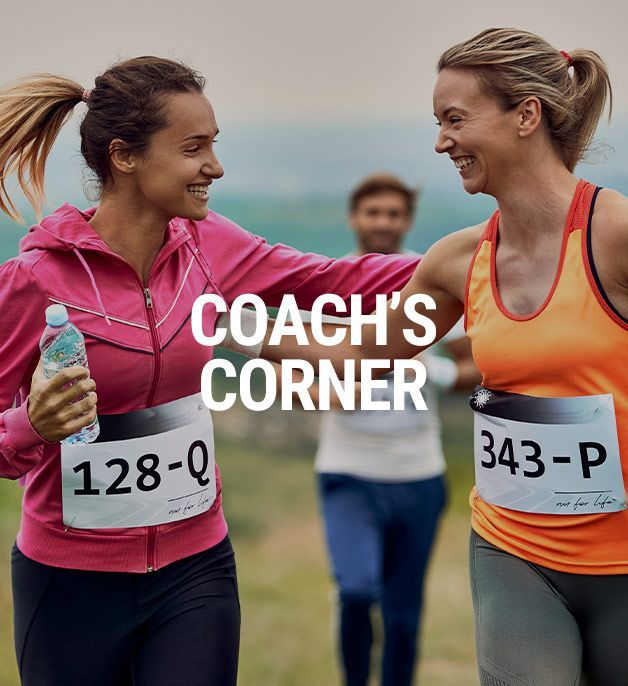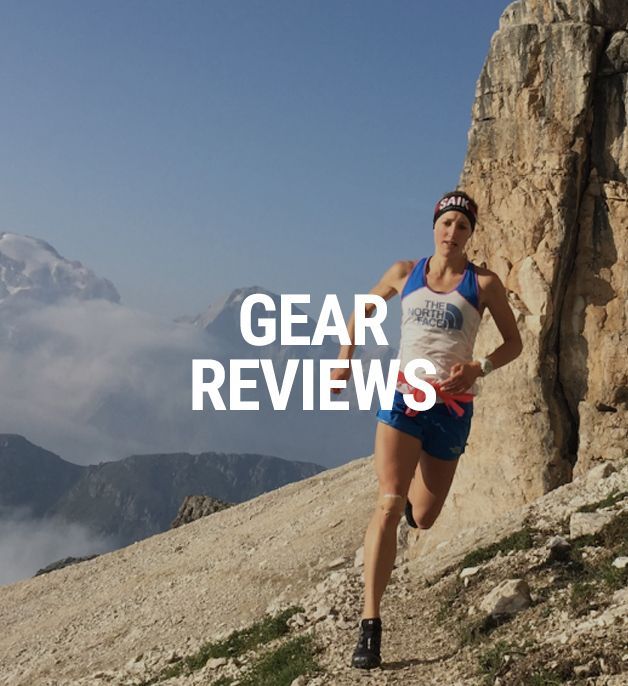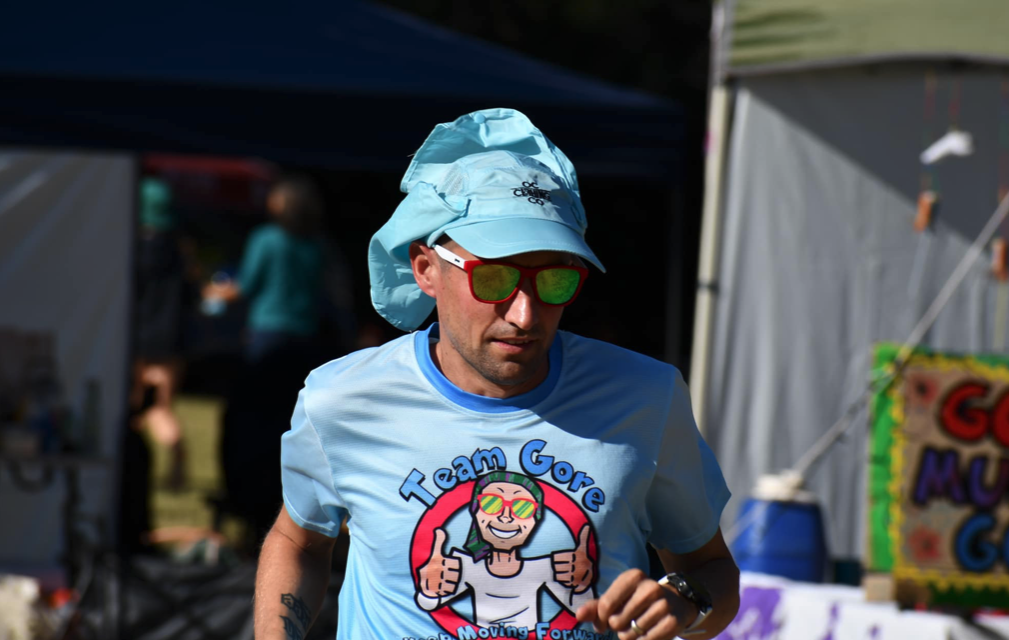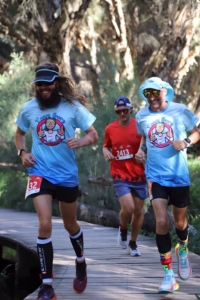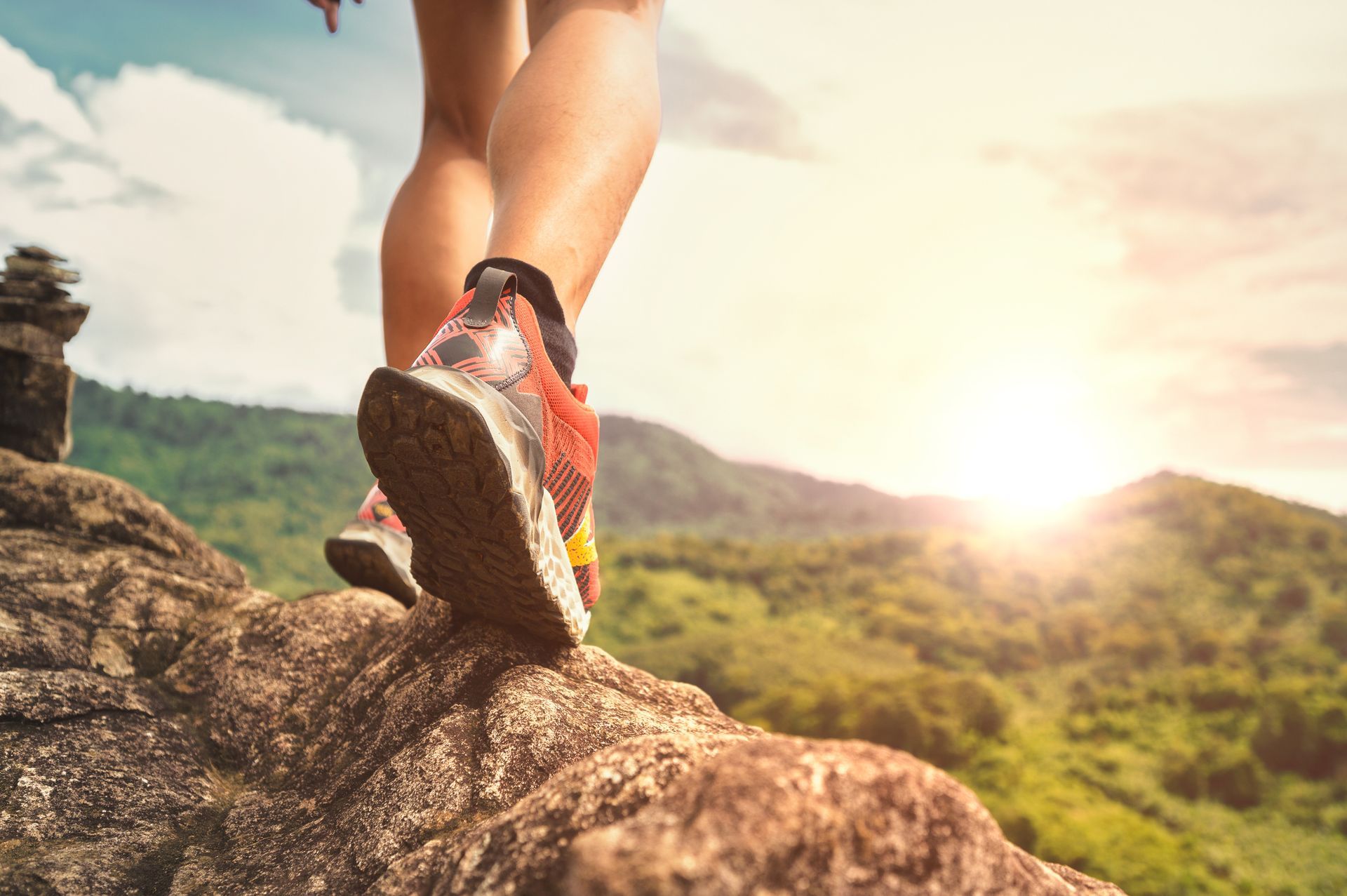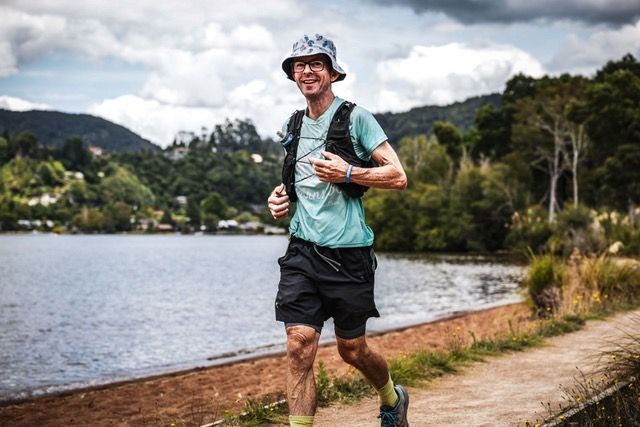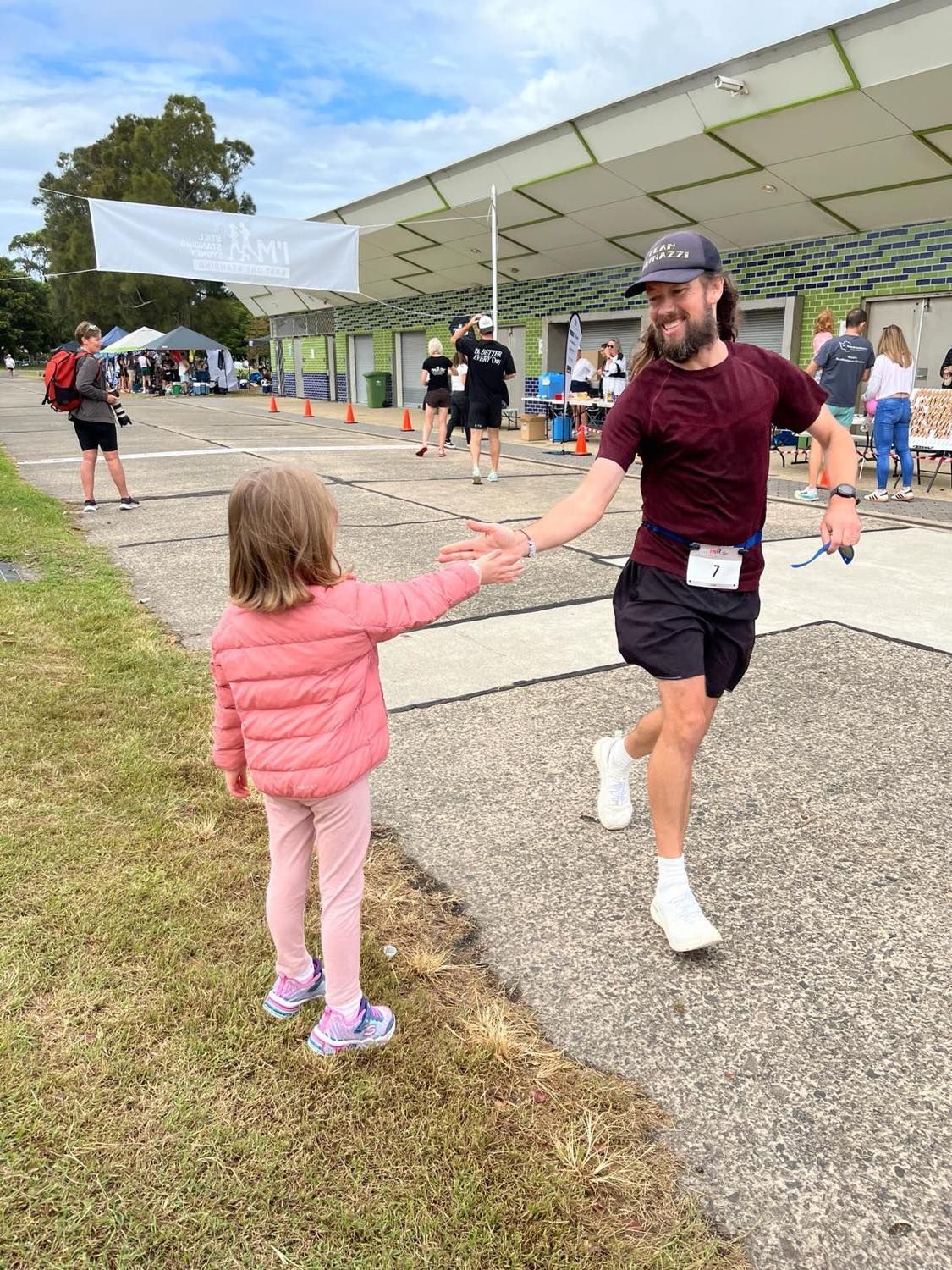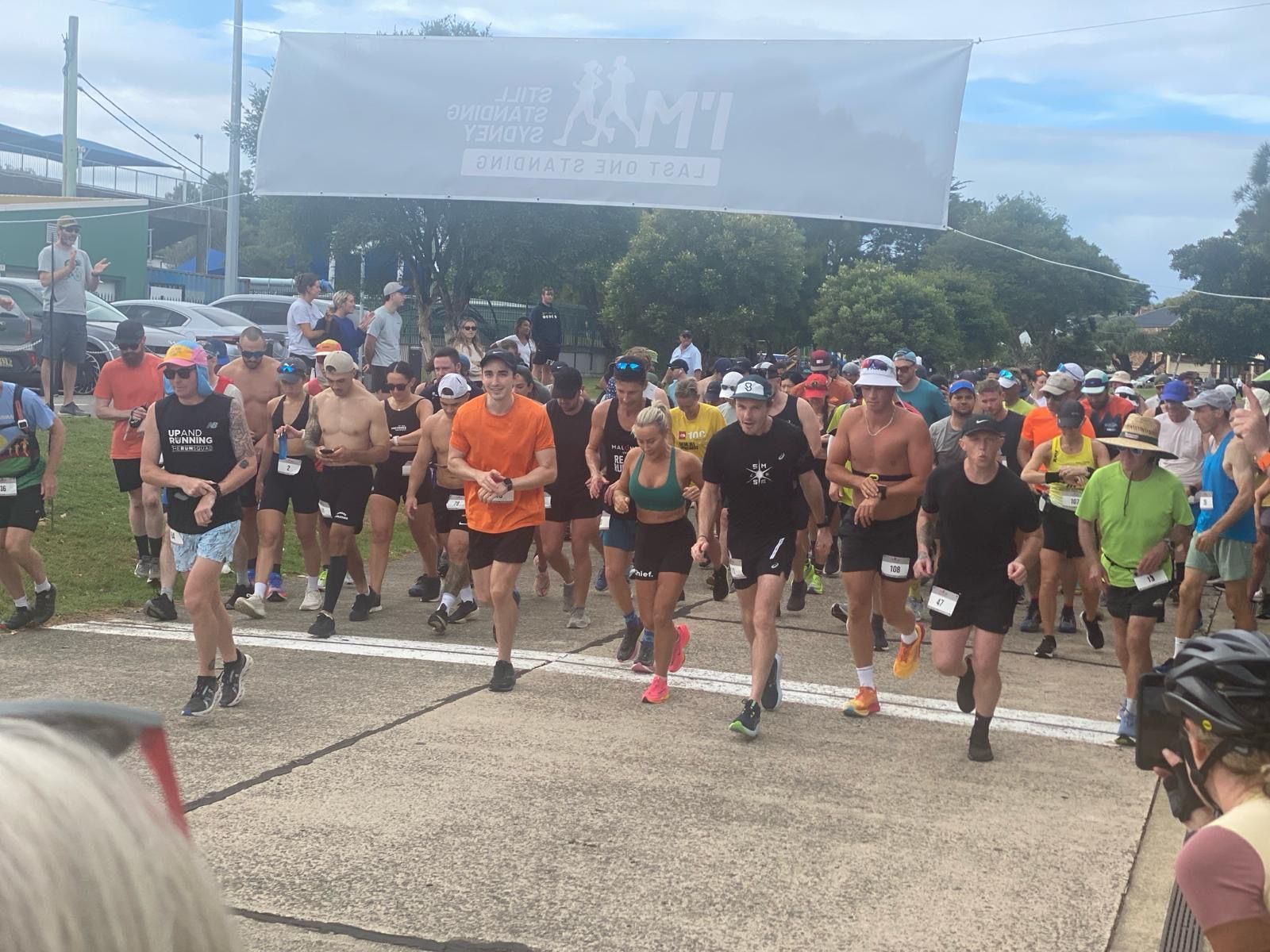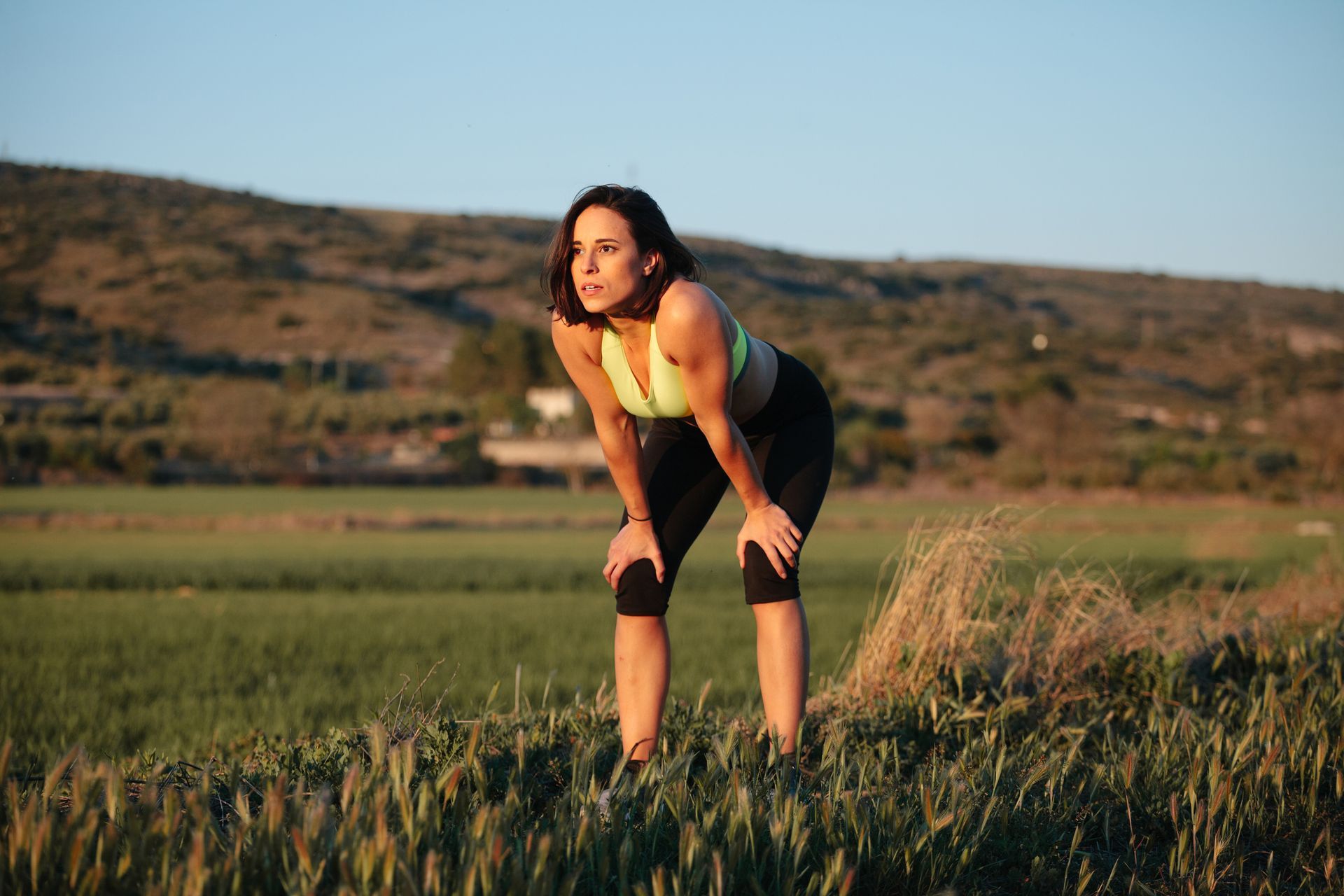The race kicked off a little late, which actually turned out really lucky for me. My watch GPS had decided to drop out right before the start, and I needed that extra time to reacquire the signal. Literally just a few seconds after hearing that beep on my watch, we were off. I probably started out a little bit quicker than I had planned to, but anything slower would have felt too clunky. I wasn’t on my own though, in the first couple of hours everyone is in high spirits and it can be easy to forget that you need to conserve energy if you hope to still be moving in 24 hours. My first lap was done at a 5:01/km pace, but then I settled into a 5:15-5:20/km pace. That was probably still a little bit too quick, but it felt quite comfortable. There was a few of us in the lead group, and we chatted as we ran, still full of energy and enthusiasm. As we got a couple of hours into it, the sun started to go down, people started to stop for short breaks, the lead group eventually broke up and the runners settled into their own individual paces and race strategies.
One of the things I love about the loop format, is that you’re never too far from your crew. I passed the crew marquee every 12-15 minutes, and each time I passed I would just call out to Gemma if I needed anything. Most times it was just a water bottle change, but other times I’d ask her to get a snack or something else ready for my next pass. Our marquee was set up about 100m before the turn around point, so I could ask for something upon entering the start/finish area (the village) and then grab it on my way back out.
Every 3 hours, we would change direction, alternating between clockwise and anticlockwise. The ‘turn-around party’ was a nice little milestone to look forward to. Each time we turned around meant we had knocked out another 3 hours. My first break was scheduled for just after the first turn-around party, around 6pm. The plan for these ‘pit stops’ (as I called them) was to be at the marquee for no more than 5 minutes. Gemma would literally set a 5 minute timer. I would change my shoes and socks, eat a warm meal, and grab anything I might need for the coming laps (in this case, it was my buff and headlamp, and my iPhone and headphones). The first pit stop was pretty slick and I was back out on course just as the 5 minute timer went off.
As the sun had now gone down, and I was running by myself, I settled into the pace I had originally planned – around 5:50/km. I had my headphones in and started listening to podcasts (RadioLab) before switching to an audiobook (Can’t Hurt Me by David Goggins). I was ticking along according to my plan (actually, slightly ahead) and pretty soon it was 10pm and I was up to my second pit-stop. Quick hot meal, quick shoe and sock change, changed my buff, put new batteries in my headlamp, and I was back out on course within 3 and a half minutes. After this break, I had scheduled Gemma some sleep time. She had a bed set up in the car, but before she left she topped up all my flasks and got some snacks out ready for me so I could ‘self-serve’ as I went past the crew marquee each time. I was also very fortunate to have Bec and Marnie in our marquee, who stepped up to help out with a few little things whilst Gemma was away.
I was still feeling pretty comfortable, and I got to a double marathon (82.4km) in under 8 hours. It was at this point last year, that I had my first walk break. This time, however, I didn’t feel like I needed it. It was always part of my plan coming into this race that I would have walk breaks, but I wanted to bank a considerable distance before doing so. I decided I would hold the pace until at least 100km, and then consider it. As it turned out, I reached the 100km point with no problems, kept running, and pushed the idea of walk breaks to the back of my mind.
Gem got up from her sleep around 1:30am (9.5 hours) to come and help me with the next pit stop. I didn’t focus on the 5 minute timer this time, I was welcoming the extra rest. We spent a bit more time with the shoe/sock change as I was developing a few blisters and needed to put some Fixomul on my toes. This pit stop was probably close to the 10 minute mark and made for my slowest lap of the whole event (25:40). It was hard to get going again. I started out with an awkward walk, but I knew I had to get into my running rhythm again or it would be game over. I forced myself into a shuffle and eventually got running again and back to the point where I felt comfortable. It was on this lap though, that I really started to notice the cold. There was a thick fog around one side of the lake and visibility had been reduced to about 10m. Gemma grabbed my jacket for me on my next pass and then she was off to bed again.
My pace had dropped back a bit, not a huge amount but to the point where I had started to wonder how much longer I’d be able to keep it under 6:00/km. I got to 12 hours and my watch told me I had covered 124.8km (actual distance was probably an even 124km). I was so close to the 125km mark I needed to be at to go for 250km! But at that point I felt there was no way I was going to have a quicker second half, so I settled on 240km as my goal. 116km sounded like an achievable distance to cover in the next 12 hours.
There was another 3-4 hours until sunrise, and it is this period that can often be the most challenging in these long events. It’s cold, it’s dark, it’s lonely. Spectator numbers dwindle, and other runners may sneak off for a little nap. My phone and headphones were on charge, so I didn’t even have the escape of an audiobook or podcast. The mental struggle and physical fatigue was starting to set in. However, the 12 hour runners had started their event by that point (3am), and I soon found myself running alongside the front runner Andrew Wait. At the time, I had no idea how much of a difference this would make to my mindset, and consequently, my performance. We got stuck in conversation and became distracted enough that we weren’t really paying attention to our pace. However, each time I did remember to look down at my watch, I was surprised to see the pace was much quicker than either of us had planned (around 5:00/km – 5:20/km). Each time we realised this we would remind each other to back it off. At some point though, I think after an hour or so of unsuccessful attempts to slow the pace down, we just decided to go with it. It felt reasonably comfortable so we just decided we would hold that pace, take advantage of the cooler temperatures and bank a few extra k’s before the sun came up. Those few hours before sunrise that I was worried about, had just seemed to fly by. Before I knew it, Gem was up and out of bed again, and it was time for breakfast. I left Andy to run by himself and I stopped for a quick break.
I tried to keep this pit stop short, but I really wanted a foot bath so that took up a bit of extra time. With clean feet, a fresh pair of socks, and a different pair of shoes, it almost felt like my feet were brand new again. The sun was just starting to come up so I got rid of the headlamp, but I kept my jacket and gloves as there was still a bit of a chill in the air. I think it got down to about 6 degrees overnight and it wouldn’t have been much warmer than that at that point. With my new feet, some warm food in my belly, and the promise of sunlight, I set out on course again. I was a little bit stiff initially, but I quickly got back into my running groove. I was still able to keep my pace down in the low 5’s, and within a couple of laps I had met up with Andrew again.
We continued on together as we had previously, but at some point he dropped back. He still continued on at a reasonable pace to hold first place, and would eventually win the 12 hour. After a quick pit stop at around 9am (which would turn out to be the last time I stopped), I was joined by my mate Chris Martin. He had been with the lead group at the start of the race, but had stopped for a 5 hour sleep during the night, and had a few other breaks since. We were able to run a few laps here and there together. Even if he stopped for a break, we would still be able to catch up with each other on a future lap. That’s another one of the things I love about this event, you can run with people who are at different stages. It doesn’t matter if you are on the same lap, or 20 laps apart.
I maintained the pace at low 5’s, and I even got a few laps in at sub-5:00/km. My quickest lap for the whole event was lap 81 during the 20th hour, which I completed in 11:44 (4:41/km). By the time I got to 20 hours I checked my watch – I was at around 210km. I started doing the maths in my head. I had made up a lot of ground in the past 8 hours and was now easily on track for my A goal. I just had to do 10km for each of the remaining 4 hours. This worked out to be 6:00/km – easily achievable, I thought. Not counting the times I had stopped for breaks, I had rarely had a lap slower than that pace for the whole event. I decided to aim bigger. 6 marathons sounded like a good goal to go for. 6 marathons worked out to be 253.2km. I rounded up to 254km to account for GPS discrepancy, which made for an even 44km in 4 hours – or 11km/h. Now the maths got tricky – I couldn’t for the life of me work out how many minutes per km that worked out to. After 20 hours of running, my brain was not working properly. I just guesstimated about 5:15/km, and ran at this pace until I could talk to Gemma and get her to work it out properly. As it turned out, I only needed to run at 5:27/km. I had been running well ahead of this, but now that the pressure was off I backed it off a little. I just focused on keeping it at (or slightly under) 5:27/km.
My last scheduled stop was at around midday – 21 hours into the race. However, as I got closer to this time I decided that I didn’t want to slow down. I was very much in the zone, ticking over the laps at a pretty consistent 13 minutes each. I didn’t want to stop and break that momentum. There was only 3 more hours left and I felt confident that I could hold on that long without another break. I did grab lunch though – I had Gemma prepare my food and then I slowed down to a walk for the brief time it took me to eat it.
The weather had well and truly warmed up by that point, and I had got set into a routine with a few little things to help keep me cool. As I came into the village, I would pass my hat, cooling towel and empty drink bottle to Gemma. She would soak the hat and cooling towel in cold water, grab a full drink bottle, and then pass it back to me on my way out. Every now and then I might grab a quick snack as well. As I ran, I continued to do the maths in my head. Just double checking the distance and time remaining to make sure I was still on target. I realised that my new goal of 253.2 would mean that I would finish pretty much exactly halfway around the 2.5km course. This was a very bad idea, as it would mean that I would have to walk about 1.2km in either direction to get back to the finish line once the 24 hours was up. That left only one other option – I would have to go a little bit quicker and make my new goal 255km, to make sure I finished at the finish line. I didn’t bother doing the maths, it was way too hard at that point. I just tried to keep the pace between 5:00/km and 5:20/km and guessed that that would be about enough.
With this event, when it is your estimated final lap, you need to grab a small sandbag to mark your position on the course when the 24 hours is up. I finished my 101st lap (252.5km) with 14 and a half minutes left to go. Barring anything drastic happening to me, I knew this was going to be enough time to get in another full lap, but I grabbed the sandbag anyway, just in case. I finished my last lap with just under a minute to spare and then made it a further 190m. As soon as they called out STOP, I stopped running and dropped my sandbag. Despite running right up until the end, as soon as the race was over I could no longer even walk properly. My wife helped me back to the tent where I finally got to sit down, put my feet up, and enjoy a refreshing Matso’s Ginger Beer.
I had covered 255.19km in 24 hours. I had smashed my pipedream goal of 250. I had beaten my previous PB (and course record) by about 40km. It came at price though – I couldn’t move the next day and had to break my daily running streak. I had 4 days off before I could manage a slow jog again. It was all worth it though. As a lot of ultra runners will be able to relate to – there’s something oddly satisfying about pushing yourself to breaking point and finding new limits.
AND JUST BECAUSE I LIKE NUMBERS, HERE’S SOME STATS FOR YOU
Total Distance: 255.19km
Total Time: 24 hours
Estimated moving time: 22hrs 57min
Overall pace: 5:38/km
Moving time pace: 5:24/km
BREAKING IT DOWN
First 12 hours
Distance: 124km
Pace: 5:47/km
Second 12 hours
Distance: 131km
Pace: 5:29/km
Slowest Lap: 25:40.4 (10:16/km) – lap 46
Fastest Lap: 11:44.5 (4:41/km) – lap 81
MEASURING THINGS BY PARKRUN
Number of 5k runs in a row: 51
First 5k time: 25:48
Average 5k time: 28:12
Fastest 5k time: 23:50 (after 19hrs of running)
Last 5k time: 26:53
(these times are calculated from 2 consecutive 2.5km laps)
MEASURING THINGS BY MARATHONS
Number of marathons in a row: 6 (plus an extra 2km)
Average marathon time: 3:57:42
Slowest marathon time: 4:22:19 (from around 90km – 132km)
Fastest marathon time: 3:41:31 (from around 198km – 240km)
(estimated times)
Pictured: Phil Gore at the 2021 Lighthorse Ultra 24hr. Photograph – Shannon Dale.
Pictured (Inset): Runners Chris Martin (left), Travis Eastman (centre) and Phil Gore (right) at the 2021 Lighthorse Ultra. Photograph – Shannon Dale.

